Pongal – A Time to Start Anew!
Pongal, a harvest festival of Tamil Nadu, signals a time for new beginnings. It marks the end of a cold winter and signals the start of the sun’s six-month journey towards the North. On this auspicious day, the Sun is worshipped as the life force behind all creation. The festival is spread over 4 days and this period is referred to as Uttarayan Punyakalam. This is a very auspicious time according to the Hindu Solar Calendar. Celebrated every year between January 15th and 18th, the timing of this festival coincides with the solar equinox – after which days begin to get longer and nights get shorter. Pongal heralds the New Year in Tamil Nadu. The people of this region believe that during this period the Gods wake up after a six-month-long slumber to shower prosperity and wealth on the mortals.
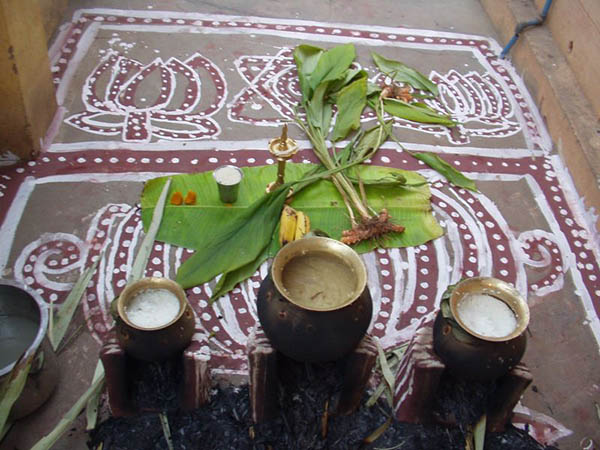
Pongal: The traditional layout for its preparation
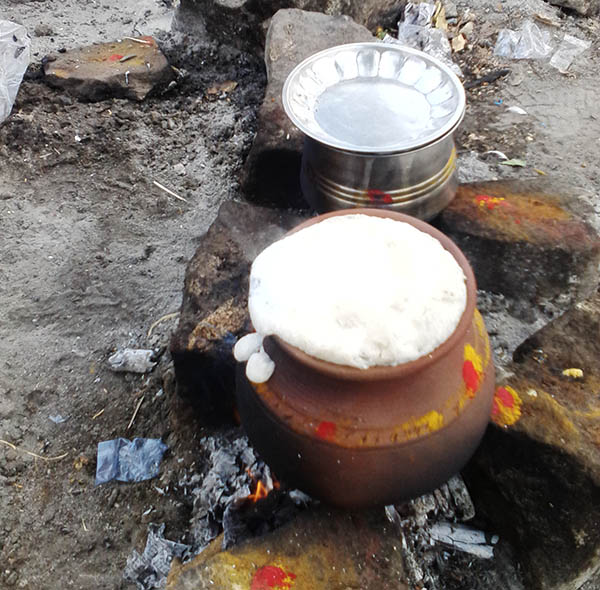
Pongalo Pongal
This all-important festival of Tamil Nadu enjoys great antiquity and can be traced right back to the Chola period, about 2000 years ago. It revolves around three crops - rice, turmeric, and sugarcane, which are predominantly grown in Tamil Nadu. The word Pongal means “to boil” or “to overflow”. It also refers to the dish which is the most integral part of this festival. This 4-day festival witnesses’ different versions of Pongal being cooked. Traditionally, Pongal is cooked in the courtyard of the house at an auspicious time. The time is normally recommended by the temple priest. Even today, in many homes, Pongal is cooked in clay pots placed on stoves made with stones. The choice of wood as fuel lends the Pongal a very distinctive flavour. The auspicious moment when the dish starts to boil and overflow, is celebrated by chants of “pongalo pongal”. People greet each other by asking, “paal pongita” or “has the milk boiled over"?
The festival of Pongal is spread over 4 days and each day has its own significance, customs, and rituals.
Bhogi Pongal
It is the first day of the main Pongal festivities. On this day, Lord Indra, the God of clouds and rains, is worshipped and thanked for the abundant harvest that brings prosperity to earth. Bhogi Pongal is hence also referred to as Indran. This day is normally spent by performing all kinds of domestic chores. Every member of the family cleans up his/her room and gets rid of old and unused items.
Every home is thoroughly washed and scrubbed. After the cleaning, the homes are decorated with Kolams– floor designs made with a white paste of rice outlined with mud. Kolams are not only welcoming and pretty, but also define the sacred area where the Pongal will be prepared.
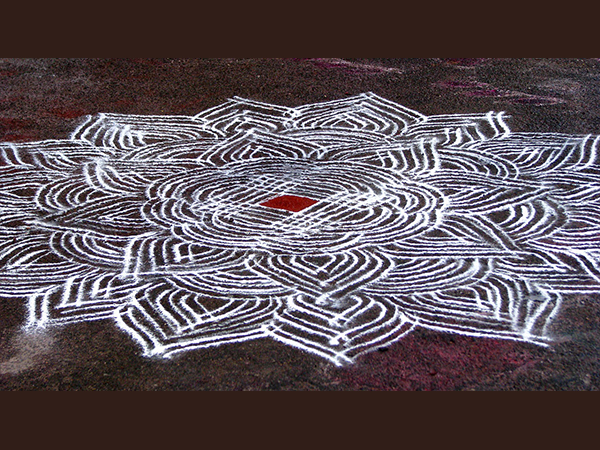
Kolam: aesthetic and welcoming!
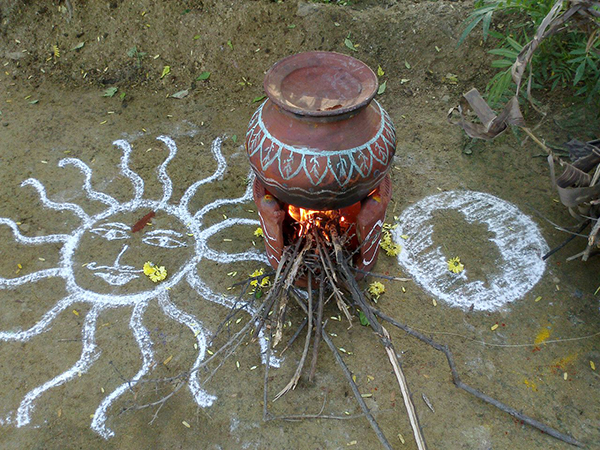
Pongal being prepared in a traditional pot
By the end of the day, a fresh harvest of rice, turmeric and sugarcane is brought in from the fields, as part of preparations for day two. The day also involves a lot of dancing and singing around bonfires in honour of Lord Indra. Leftover hay from agricultural fields and unwanted household goods are added to the fire to keep it going. It signifies getting rid of all past baggage and gearing up for a new start.
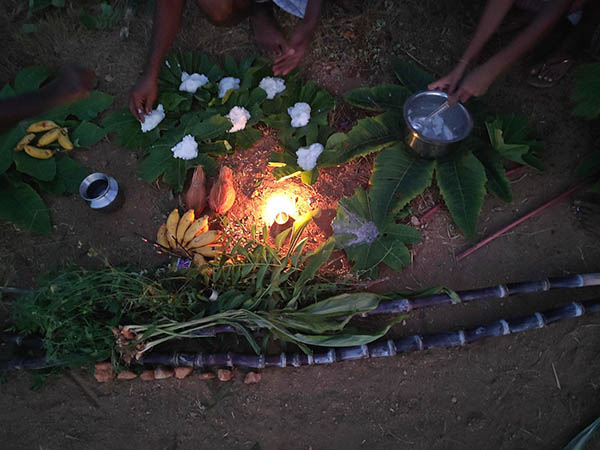
Pongal offerings
Surya Pongal/Thai Pongal
The second day of the festival is considered to be the most important. It is called Thai Pongal or Surya Pongal. The rituals on the second day are very elaborate. The ceremonial worship starts with the drawing of the Kolam. This is done by the womenfolk early in the morning after their bath. The members of the household wear new clothes and then the all-important ritual of preparing the Pongal begins. Rice is boiled in an earthen pot which has a turmeric plant tied to it. The pot is put atop a clay stove in the courtyard of the house. The pot is also very beautifully painted. Once the rice cooks and boils over, it is then offered to the Sun God, along with bananas, coconuts and sticks of sugarcane. The Pongal is first offered to the Gods, then to the cattle, and it is only at the end that it is distributed amongst friends and family. Maintaining this order is considered to be of utmost importance.
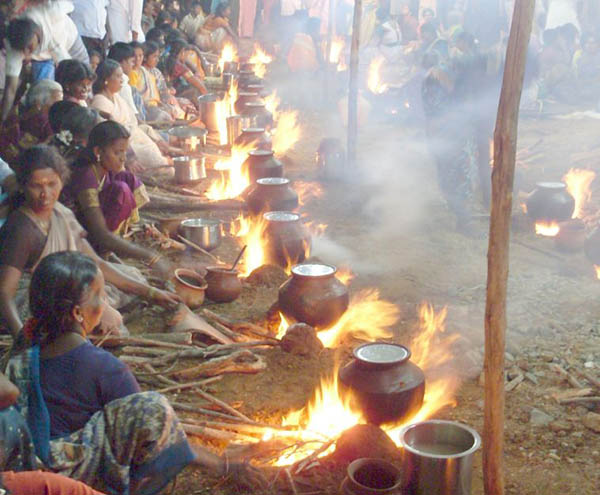
Women waiting for the Pongal to boil
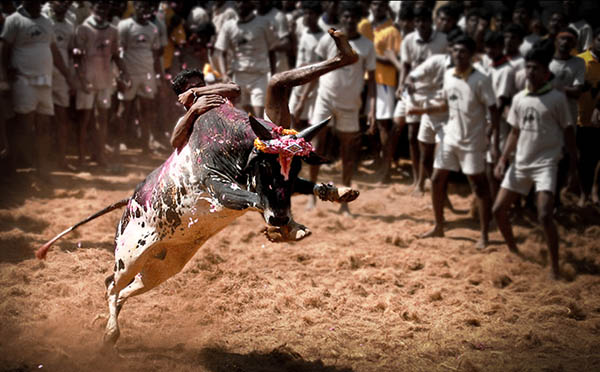
Jallikattu
Mattu Pongal
The third day is dedicated to worshipping the cattle. They are integral to farmers and their livelihood, and on this day their blessings are sought. The cattle of the household are given a ceremonial bath in the morning. Then their horns are cleaned, polished, painted, and decorated with flowers. Once the cattle have been embellished, aarti is performed so as to ward off the evil eye. The worship of cattle has its roots in a legend which goes as follows. It is believed that Lord Shiva had once asked his lovable bull, Basava, to go to earth with a message for humans, that they must have a bath and oil massage daily, and eat once a month. Basava instead conveyed the message that humans should eat daily, and take a bath and oil massage once a month. Shiva was furious and exiled his most loving bull to live on earth forever. He told Basava that henceforth he will have to till the earth with a plough to aid the farmers to cultivate and produce food. Cows and bulls are revered till today in the region as they are considered to have descended from Basava, the divine Bull. Pongal also involves a traditional cattle sport called Jallikattu.
Kaanum Pongal
This is the last and the fourth day of the festival and marks the end of the Pongal festivities. It is essentially a day of merriment on which Pongal songs and dances are performed. On this day, a particular ritual is performed. Sweet Pongal, betel leaves, bananas, betel nuts, two sticks of sugarcane, coloured rice (red and yellow), and other preparations are together placed on the washed turmeric leave sand left in the courtyard. The primary item, rice, is placed in the middle of the turmeric leaf. This is considered to be an offering to birds. All the women of the household assemble together in the courtyard and offer prayers for the family’s prosperity in general and for their brothers’ well-being in particular. This is followed by aarti with turmeric water, rice, vermillion, and limestone. This water is considered very holy and is sprinkled everywhere in the premises of the house. Kaanum Pongal is considered to be a very auspicious day to arrange marriage proposals and to forge new bonds and relationships.
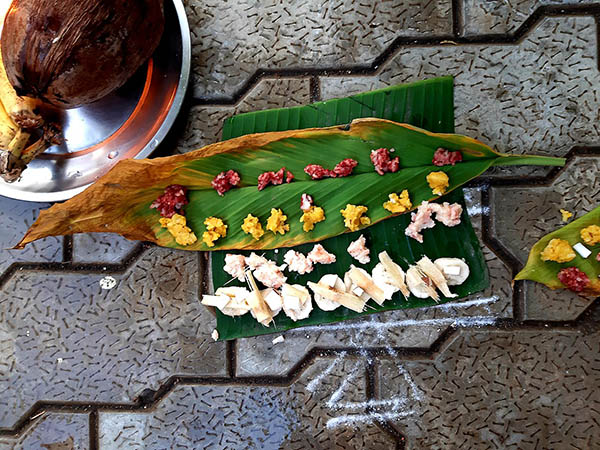
Kaanum Pongal offerings
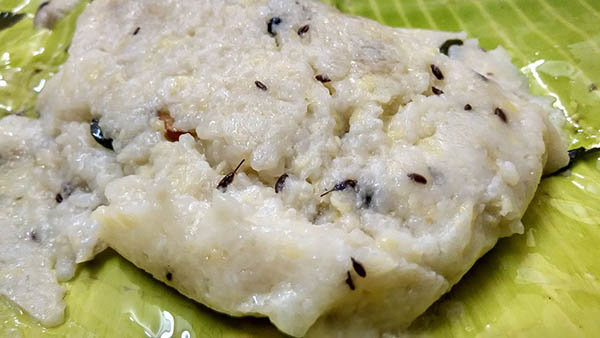
Ven Pongal: The all-time favourite
Delicacies of Pongal
The core dish of the festival is undoubtedly Pongal. This traditional dish is prepared with rice, dal, and ghee. Different variations are made using these essential ingredients. Rice, sugarcane, cereals, and turmeric are the staple crops of Tamil Nadu. These are harvested in the Tamil month of Thai and play a significant role in the preparation of Pongal. The festival is therefore often called Thai Pongal. Traditionally, the first rice that is harvested is used. This is the reason why the Pongal is first offered to the Sun God as prasadam to thank Him for a good harvest. Always considered auspicious, turmeric is an integral part of Indian customs and rituals. Turmeric leaves are also used to decorate the earthen pot in which the Pongal is prepared.
Sakkarai Pongal is the sweet version (in which jaggery is added) and Ven Pongal is the salted version of this sacred dish. The flavour and aroma of Pongal is enhanced when it is made in pure ghee. To prepare Sakkarai Pongal, a concoction is made of rice, milk, moong dal, jaggery, and ghee, and is brought to a boil and allowed to spill over. Ven (white) Pongal, apart from being a traditional preparation of the festival, is also a popular breakfast dish of the state and is now also served in different avatars all over the country.
Along with Pongal, other delicacies too are prepared during this festival season. One of the important dishes is Pongal Kootu. Kootu means a combination of lentils and vegetables. This dish is basically a sambar including seven seasonal vegetables. Pongal Kootu can be prepared with a combination of broad beans, pumpkin, ash gourd, potato, raw banana, sweet potato, and lima beans. Kara Murukku is a delicious and whole some snack made with urad dal and is a crispy treat served as part of Pongal feasting. Its unique round-coiled shape and crunchiness makes it an all-time favourite evening snack too.

Sakkarai Pongal: Sweet offerings
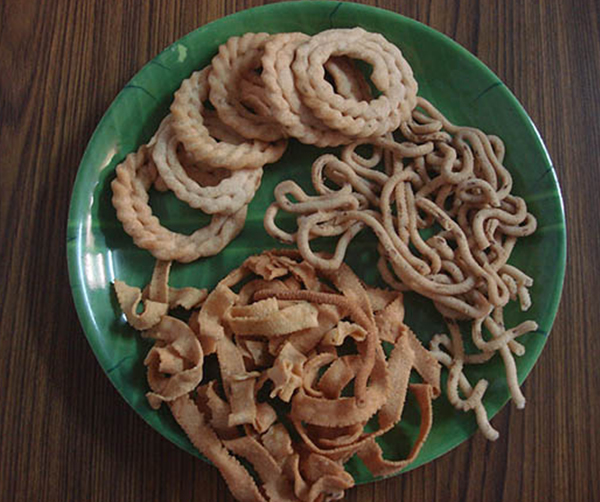
Crispy Pongal delicacies
Harvest festivals are celebrated to show gratitude for the gifts that Mother Nature has bestowed on us. Pongal is a unique festival that strengthens bonds and brings the community together.
 Government of Indiaa
Government of Indiaa

 Recognizing the ongoing need to position itself for the digital future, Indian Culture is an initiative by the Ministry of Culture. A platform that hosts data of cultural relevance from various repositories and institutions all over India.
Recognizing the ongoing need to position itself for the digital future, Indian Culture is an initiative by the Ministry of Culture. A platform that hosts data of cultural relevance from various repositories and institutions all over India.
